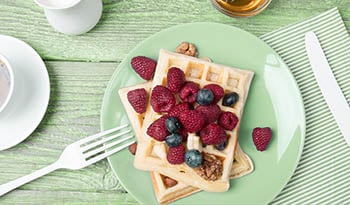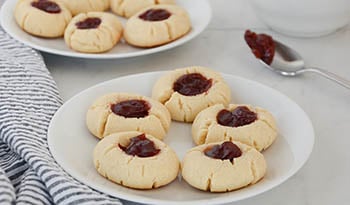Stock Your Kitchen with a Dietician’s Top 10 Gluten-Free Essentials
DISCLAIMER:This blog does not intend to provide diagnosis...
- In this article:
- What is Gluten?
- Gluten-Free Certification
- Gluten-Free Diet Essentials
- Takeaway

Perhaps you have begun a gluten-free lifestyle change, and are looking for additional ways to stay on track with your new diet. Or maybe you have followed a gluten-free diet for years, but are looking for new ideas. This guide will review gluten-free diet essentials that make it easier to continue or get started with a gluten-free life. Let’s begin with the basics!
What is Gluten?
Gluten is anything that contains wheat, barley, or rye grains. In addition, oats contain gluten from processing but can be purchased certified gluten-free through some companies. For a product to be labeled gluten-free in the United States, it needs to have less than 20 ppm (parts per million) of gluten. This is an amount that is said not to aggravate those with Celiac disease. In other countries, less than 5 ppm of gluten is needed to be labeled as gluten-free.
Gluten-Free Certification
Here is where it gets tricky. First, gluten-free labeling is optional. In addition, testing for any gluten in the product is also optional. So, if you have Celiac disease or an allergy or condition that is greatly upset by gluten contamination, you should look for certified gluten-free products. This certification means that they test the product regularly. There are various badges and labels that may show certification on the product. However, the key is to look for the word “certified.”
Gluten-Free Diet Essentials
1. Supplements Labeled as Gluten-Free
Gluten-free labeling on supplements is also optional for manufacturers. So, when you are looking for gluten-free supplements, you must read the description and ingredient label to see if it states that it is gluten-free. Wheat-free does not mean gluten-free, so it is important to look for the terms “gluten-free.”
Gluten may be found in starch fillers in supplements such as dextrose or other starches. However, more commonly, these starches are made from corn or rice. Occasionally, supplements will disclose that the starch is rice-based or clearly state the product is gluten-free.
Another common gluten source is gluten-containing wheat, barley grass, or oats. Wheatgrass is naturally gluten-free, but there is often gluten that sneaks in during production from the whole plant. Therefore, wheatgrass or oat-containing products must state that they are gluten-free.
2. Gluten-Free Certified Oats
As mentioned, you may want to look for oats that are certified gluten-free when following a gluten-free diet. Oats and oatmeal are naturally gluten-free but are often contaminated with wheat, barley, or rye in production.
Certified gluten-free oats are beginning to make an appearance at most grocery stores, however, this is an item you may need to purchase online or at health food stores, depending on your local availability.
3. Quinoa
Quinoa is actually a pseudo-grain meaning it is technically a seed! Therefore, quinoa is naturally gluten-free and also a complete protein. This makes quinoa a wonderful pantry staple to include with any meal throughout the week. You can even substitute hot cooked quinoa for a hot breakfast instead of cream of wheat or traditional cereals. Just cook according to the package directions and then top with your favorite fruits, nuts, and spices!
4. Gluten-Free Baking Flour
This is a must-have if you enjoy baking from home. These gluten-free flour mixes are often a blend of tapioca, rice, and/or potato starches. They offer the convenience of being able to substitute the gluten-free flour blend equally with wheat-based flour. You can make cookies, muffins, pancakes, and more. Another option is to substitute wheat flour with almond flour or coconut flour or meal. The gluten-free flour blends are beginning to appear at local grocery stores, but they may only carry one brand. If you are looking for a specific blend of gluten-free ingredients, you may wish to shop online.
5. Gluten-Free Wraps
Gluten-free wraps make a nice option for putting together quick lunches. There are many new gluten-free wrap options out there such as coconut wraps. Some of these wraps may be labeled as “paleo,” which means they have been made without grains. Instead of grains, they often use a blend of seeds, coconut, and/or tapioca.
This provides a little more fat and protein to keep the meal balanced and nutritious. You may find many grain-free wraps or cracker options that give a nice variety to lunch and help keep a gluten-free lifestyle less restrictive. We like to purchase our coconut wraps online as there’s generally a greater variety of flavors and availability. Then, simply fill with traditional lunch fillings such as lean meats or legumes, veggies, and a condiment of choice!
6. Gluten-Free Pasta
This is one of my favorite options for weeknight meals and a must-have pantry staple. Lentil, chickpea, or bean pastas are naturally gluten-free and high in protein to help keep weeknight meals simple. Another option that offers the mildest taste for the pickiest of eaters is brown rice pasta, which has a nice taste similar to that of traditional wheat pasta and offers a whole grain option. You may find other gluten-free pastas that are a blend of corn, quinoa, and/or rice. These are easier to find at local grocery stores. However, if you want a specific shape or ingredient, it is better to shop online.
7. Gluten-Free Pizza Crust Mix
Maybe you don’t have a local restaurant that makes gluten-free pizza, and you need to do it yourself. Or, perhaps you would like to cook more from home. Keeping a pizza crust mix on hand is a stress-free option when you want a pizza night. These are dry mixes that you simply add water to and make a dough. The process is much simpler than traditional pizza dough: simply mix and bake! Then, add your favorite toppings, and you are ready for pizza night.
8. Coconut Aminos
Soy sauce traditionally contains wheat in processing. You can also purchase gluten-free labeled soy sauce. This is simply a soy sauce that has been made without wheat and is safe for the gluten-free lifestyle. Coconut aminos are another alternative to soy sauce. Coconut aminos taste very similar to soy sauce and are made from coconut tree sap. You can also find coconut amino teriyaki sauces which traditionally have wheat from soy sauce as an ingredient. This makes for easy weeknight night meals and flavoring stir-fries.
9. Arrowroot or Cornstarch
These are both gluten-free starchy powders that are used to thicken foods. Arrowroot powder is a starch from a few tropical root plants. Either one is great to have in the pantry to thicken a soup or sauce. Sometimes they are also used in baking. Traditionally, wheat flour is used to make gravy or thicken a soup. But, you can easily substitute a gluten-free starch! These are especially helpful to have around during the holidays when you may cook more sauces and gravies.
10. Gluten-Free Personal Care
Last but not least, you may want to pay attention to personal care products if you are sensitive to gluten. Especially, look into gluten-free personal care products and cosmetics that you put on your face such as lipstick and face creams. Lotion is the most common personal care product to contain wheat, specifically. This is more difficult to spot on a label as there may not be a gluten-free description on the product. It is better to read the ingredient list and look for wheat as an ingredient.
Takeaway
The gluten-free lifestyle does not have to be difficult. The challenge is that gluten-free items may not be readily available in your town. Or, maybe you were not sure what else to include in your diet. Thankfully, over the last five years, gluten-free products have become more available in stores and online. Once you have stocked your kitchen with some of these essentials, it makes gluten-free eating less stressful and more convenient.
References:
- Biesiekierski JR. What is gluten? Journal of Gastroenterology and Hepatology. 2017;32(S1):78-81. doi:10.1111/jgh.13703
- Home. Gluten Intolerance Group of North America - GFCO. Accessed June 29, 2021. https://gfco.org

 By Nicole Morgan RDN, LD, CLT
By Nicole Morgan RDN, LD, CLT


